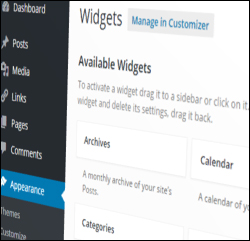 In Part 1 of this step-by-step tutorial, we explained how to use widgets in WordPress and in Part Two, we explained how to configure a text widget.
In Part 1 of this step-by-step tutorial, we explained how to use widgets in WordPress and in Part Two, we explained how to configure a text widget.
In this section you will configure other frequently-used WordPress sidebar widgets.
How To Add A Categories Widget To Your Blog Sidebar
Now that you have set up a text widget containing a help button, let’s configure a widget for displaying Post Categories on the sidebar.
The Categories widget already displays on your sidebar navigation section by default. Place this widget wherever you want your post categories to display by clicking and dragging it in your sidebar area …

(Post Categories widget)
![]()
Before adding a Categories widget to the sidebar, we recommend configuring your post categories inside your WordPress dashboard …
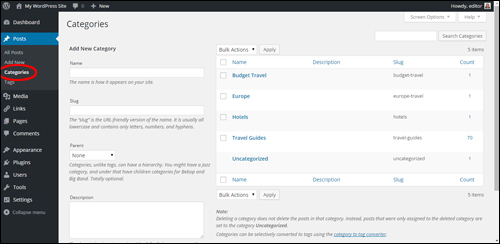
(WordPress Categories Panel)
Note: We are currently putting together tutorials on setting up categories in WordPress.
Let’s configure your categories settings as described below:
- In Title: type something that blog readers will understand, like “Choose A Topic…” (1)
- Check Display as dropdown if you have too many categories (this significantly reduces the size of the widget content by displaying all categories in a drop-down menu). If you plan to publish posts under a few categories only, then leave the Display as dropdown box unchecked. (2)
- You can leave the other options unchecked, or see the additional notes on configuring this widget below.
- Click Save to update your settings …
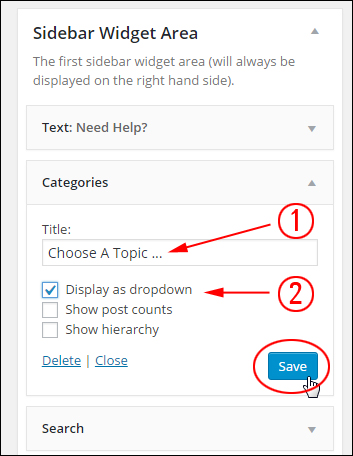
(Configuring a WordPress Categories widget)
Click Visit Site or refresh your page to see how your content will display to blog readers …
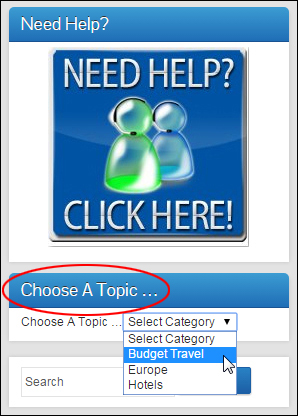
(WordPress Categories widget added to sidebar area)
![]()
Tips:
- Change the default Uncategorized post category to something more meaningful.
- If you use nested categories on your site, you may want to check the Show hierarchy box, otherwise leave this box unchecked.
- To display the number of posts published in each category on your site, tick the Show post counts check box …

(Category widget options – Post Count Enabled vs Post Count Disabled)
Add Recent Posts
The Recent Posts widget typically displays in the sidebar by default. All you need to do is configure the widget.
Click on its widget title bar to configure its settings …
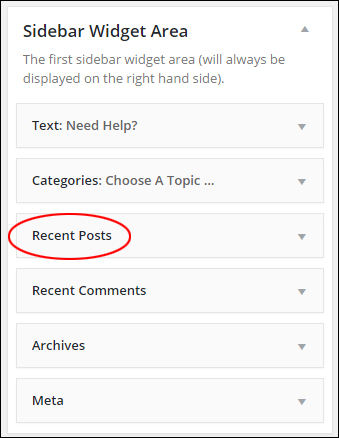
(Recent Posts WordPress widget)
There is very little to set up here. You can add a widget title, select the number of posts to display and opt to display post dates. If you’re happy to use the default Number of posts to show setting, then just leave the widget as is, otherwise enter the number of posts to show and click Save when done …
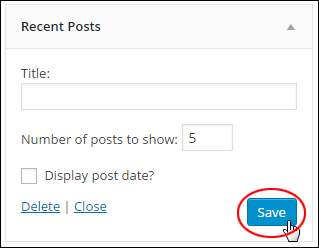
(Recent Posts WordPress widget settings)
Your most recent posts will display on your sidebar …
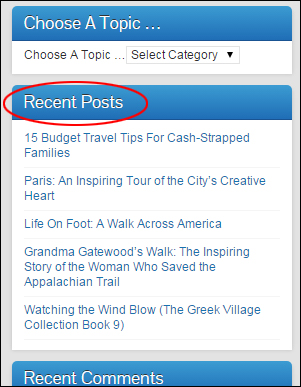
(Recent Posts widget displayed on sidebar area)
A tutorial is provided on creating and editing a post in WordPress here: How To Create A New WP Post
Displaying Your Site’s Main Pages
Next, let’s add a widget to your sidebar for listing pages.
Find a Pages widget in the Available Widgets section …
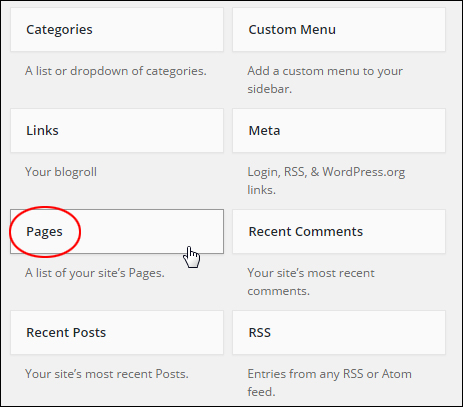
(Pages Widget)
Drag the Pages widget to your sidebar widget area …
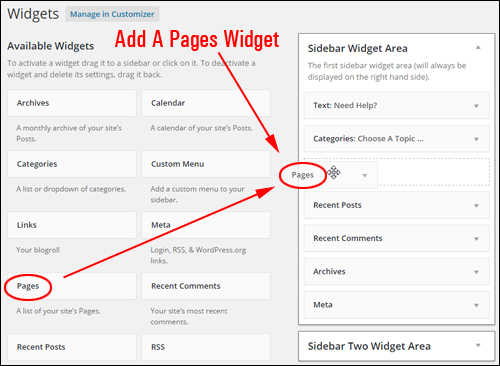
(Adding a Pages widget to the sidebar)
The Pages widget lets you configure the following settings:
- Title: Add a title to the widget (e.g. “Pages“) (1)
- Sort by: Sort how your pages display: by title (i.e. alphabetically), by page order, or page ID. (2)
- Exclude: Hide pages on your sidebar navigation area (3) …
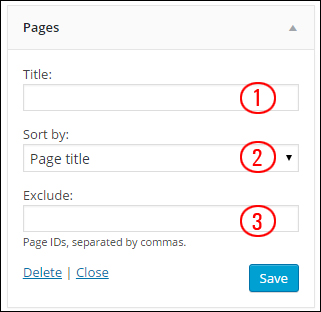
(Pages Widget settings)
By default, pages will be listed by title in alphabetical order. If you want to display pages using another option, then choose a different method from the Sort by: drop-down menu …

(Pages Widget settings – sorting options)
To exclude pages from showing in your sidebar, enter the Page Ids for all the pages you would like excluded separated by commas into the Exclude field of the widget …
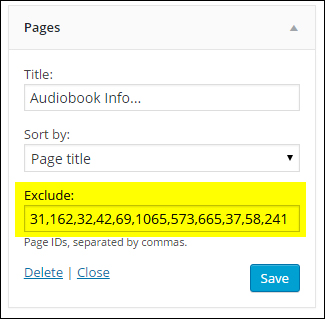
(WordPress Pages Widget settings – exclude pages by ID)
A step-by-step tutorial is provided on how to find a WordPress post or page ID here: How To Find A WordPress Page Or Post ID
Click the Save button when finished and click Close at the bottom of the widget box to minimize the widget.
Links to your site’s main pages will now display on your sidebar section …
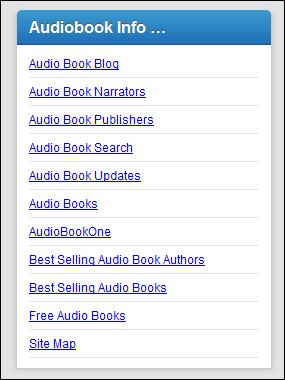
(WordPress Pages Widget on blog sidebar)
![]()
Tip: You can add multiple Pages widgets to the sidebar menu. This is helpful if you want to display separate page groups on the sidebar section (e.g. “Products”, “Legal Pages” etc.)
Display Links On The Sidebar
Now, we’ll add a widget to your WordPress sidebar for displaying external links (e.g. to useful resources, affiliate links, etc).
Before adding a Links widget to your sidebar, we recommend configuring the Links feature first …
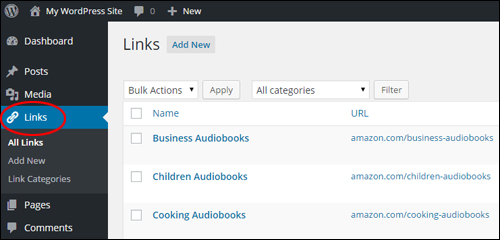
(WordPress Links section)
Note: We plan to create a separate tutorial that explains how to set up and use Links.
To add the widget, find a Links widget in the Available Widgets section …
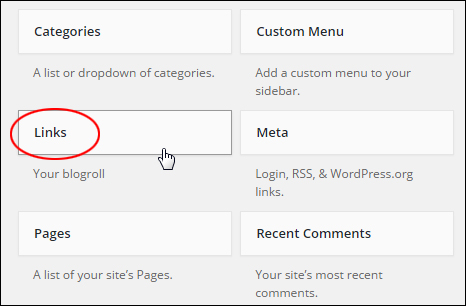
(Links Widget)
Drag the Links widget to your active area …

(Making Links Widget active)
The widget offers a number of configurable options, including the ability to specify what information to show about your links and how many links you want to display on your sidebar navigation menu …

(WordPress Links Widget Settings)
You can add as many separate ‘Link Widgets’ to the sidebar as you want. As you will see in a moment, this lets you create and display specific lists of links on your site …

(Add Multiple Links Widgets To The Sidebar Navigation Area)
You can sort links by Link title, Link rating, Link ID, or display links in Random order …

(Links widget: ‘Sort by:’ drop-down menu)
You can also create and display a list of items for a specific category, by selecting a link category from the ‘Select Link Category’ drop-down menu …

( WordPress Links widget: ‘Select Link Category’ drop-down menu)
When you have finished configuring the Links Widget, click the Save button. Your links will display immediately on your site …

(External links added to sidebar section)
As the above example shows, you can display specific external links to your site visitors (e.g. a list for a specific link category only), and add multiple lists of links to the WordPress sidebar.

***
This is the end of part three of this tutorial.
To view the rest of this tutorial, click here:
***
"I love the way your email series "Infinite Web Content Creation Training Series" is documented and presented. It is very absorbing and captivating. The links and tutorials are interesting and educational. This has motivated me to rewrite my content following the concepts I am learning from the email series." - Mani Raju, www.fortuneinewaste.com